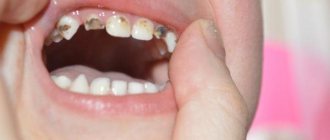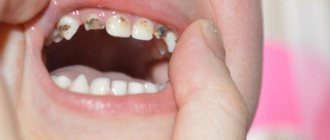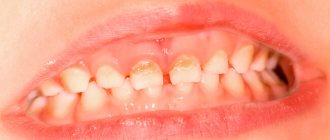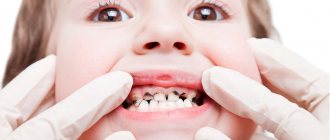From this article you will learn:
- how to silver teeth - photo,
- indications and contraindications for the procedure,
- preparations for silvering teeth in children.
The article was written by a practicing dentist.
Silvering of teeth is a conservative method of treating caries of primary teeth in children, which consists of impregnating the caries-affected areas of the tooth with silver. This method is most often used in children aged 2-3 years, or in children over 3 years old - with a strong fear of the dentist. The method has its drawbacks, and is not indicated for every child, but in some cases it is the only way to do without removing teeth before their physiological change.
In dentistry, the following drugs are usually used to silver baby teeth in children: Saforide or two-component Argenate. The effectiveness of silver plating will largely depend on the stage of the carious process. The method will be especially effective in the initial form of caries in the white spot stage, as well as superficial caries (i.e. in cases where the carious process does not extend beyond the enamel layer). With average caries, when dentin is already damaged, the method has very limited effectiveness.
Teeth after silvering: photo
Silvering of teeth in children can be performed from the moment they erupt (from 6 months), the procedure does not require anesthesia and is well tolerated even by emotionally unbalanced children. The visible disadvantage of the method is the change in the color of the teeth - which must be warned in advance to the child’s parents, having obtained their consent to use the method. In this case, only demineralized areas of tooth enamel affected by caries change their color (the color of healthy enamel does not change).
Why are teeth silvered?
A feature of early childhood caries is its very rapid progression, which often leads to tooth loss. Some parents do not consider this a serious problem, since temporary teeth should fall out soon anyway. But premature loss of primary occlusion elements can cause orthodontic problems in adults. Therefore, it is extremely important to stop the development of the disease as early as possible.
If you have time to silver the milk teeth at the white spot stage, you can avoid the spread of the process deep into the tissues and preserve them until the time of natural replacement.
Psychological consequences
Blackening of teeth is a side effect of silvering. Naturally, it can cause complexes in a child. It all depends on his environment.
If a child is home-schooled and spends time only with grandmothers, aunts, sisters and brothers, then this temporary inconvenience can be easily tolerated.
It may also be that the child goes to kindergarten, where there are already children with black teeth from the same procedure. In this case, peers who are accustomed to such a phenomenon are unlikely to tease him.
If, after silvering, the child begins to be considered a “black sheep” and is subjected to daily ridicule, the following must be done. Ask the teacher to explain to the kids why their peers have dark teeth and what are the benefits of this state of affairs.
If the teacher is able to present this in a favorable light (after all, the teeth of this boy or girl will be the healthiest in the group), then who knows, maybe the children will ask their parents for the same silvering procedure, and the method will become fashionable.
Read about the possible causes of a brown coating on the tongue in adults and children. This article is all about peri-implantitis, its symptoms and modern options for getting rid of the problem.
Follow the link https://dr-zubov.ru/lechenie/yazyk-l/makroglossiya-chto-delat.html if you are interested in what macroglossia is in children and adults, and why the disease is dangerous.
What is silver dental treatment?
The method of silvering children's teeth is not new in dentistry. For many decades, doctors have been using this procedure to treat the initial stages of caries in young children.
Silver plating is not an entirely accurate term. For treatment, not pure noble metal is used, but its active salts. The composition of the medicinal product includes silver fluoride diamine. When it interacts with the inorganic component of the enamel, microscopic crystals of silver phosphate and calcium fluoride are formed, which seal the dentinal tubules and prevent the entry of pathogenic microorganisms. At the same time, silver ions suppress microbial activity.
The tooth surface treated in this way becomes much denser and more resistant to the action of acids that enter with food or are released by bacteria in the course of their life.
Today, the most common drugs for silvering teeth in children are the Japanese “Saforaid” and the Russian “Argenat”. They have a comprehensive therapeutic and preventive effect on tooth enamel and are absolutely safe for the child’s health.
Description of the procedure
Silvering occurs quite simply, and mainly in the dental office. In this case, a small patient should already have a full set of baby teeth.
To begin with, the doctor examines the oral cavity and gets acquainted with the baby’s medical history. If there are no contraindications, then he gets down to business:
- The enamel is thoroughly cleaned of plaque, isolated from saliva and dried with a stream of air.
- The doctor dips the swab into a solution with silver and treats the smooth surface of the teeth with it, rubbing it for 5 minutes.
- Afterwards, dentin and enamel become significantly denser for several months. The film of insoluble silver salts formed on them effectively fights microbes, reducing plaque.
It was noticed that the fluoride-containing solution was not able to penetrate inside. This ensures the integrity of the pulp, and powerful protection on the surface maintains the health of hard tissues.
The process of creating an anti-caries film does not require the use of abrasives and anesthetics. Initially, the silvering procedure is carried out 4 times at intervals of 2 days, and then repeated every 4 months. Your dentist will help you create the optimal schedule that suits your specific case.
How are baby teeth silvered?
The silvering technique is simple and does not take much time. The tooth surface affected by caries is thoroughly cleaned of plaque and the medicinal preparation is carefully applied with a cotton applicator. That's all. This procedure does not cause any discomfort or negative reaction in the child.
How many times it is necessary to repeat the silvering process is decided individually in each case. Usually 3-5 procedures are enough, which are performed daily or every other day. Such courses are repeated every 4-6 months.
Write a comment
Olga
January 5, 2015 at 15:00
Indeed, with the appearance of the first tooth, we need to start thinking about protection. Having seen how a child we know at the age of four has already had several baby teeth pulled out, and the rest have caries, we have been taking our son to the pediatric dentist since he was a year old. And when at the age of three he we began to see minor signs of caries; without thinking about the price, we did fluoridation, since I consider it more effective than silvering. The development of caries has really stopped, but of course there must also be adequate hygiene and a good electric toothbrush. You can’t save on our children’s teeth .
Lelya.
February 4, 2015 at 11:58 am
Hello! We are also faced with the problem of baby teeth. My daughter is 6 years old and lately she has been complaining about pain in her teeth. I somehow didn’t pay attention to this, because she is a very good dreamer and I told her that she needed to take care of her teeth and eat less sweets. And then I actually discovered black spots on her back teeth and realized that a pediatric dentist was inevitable. So he advised us to silver plate. Of course, it’s a little expensive, but we didn’t refuse, although in our case it was already a little too old. This is real protection for children's teeth. Silvering not only slows down the loss of baby teeth, but also protects them from caries, and therefore from painful sensations for the baby. Our son is still growing, he is 8 months old and has no teeth, as soon as we appear for silver!!! What we recommend to everyone!
Julia
April 13, 2016 at 11:13 pm
My child is 3.5 years old. Black spots appeared on the front teeth. We went to the children's clinic and they said it was caries. They also reported that they do not treat caries on the front teeth, nor do they do silver plating. They suggested going to a paid clinic. There they also refused us, they said we don’t need to silver it, let it stay that way, if it bothers us, we’ll remove it. Fluoridation is not done. They advised, however, to use Rox gel to remineralize teeth.
Valya
October 20, 2016 at 11:22 am
I don’t know for what reason they refused to silver your child’s teeth, but my front teeth were silvered at the age of 1.5 years and they told me to carry out this procedure every 6 months. Absolutely free. To be honest, we were not offered any paid alternatives. Yes, my daughter walks around with black teeth, but I think the most important thing is that she has them. Soon we will be 3 years old, other manipulations with her teeth may be available
Karina
October 10, 2022 at 01:02 pm
At the age of 4, my son’s front teeth began to decay from hard tap water. The pediatric dentist recommended silver plating. So we kept going and silvering until his milkweeds began to fall out. The procedure in pediatric dentistry was carried out free of charge. The condition of the remaining teeth was normal. The son walked around and scared everyone with his black teeth.











